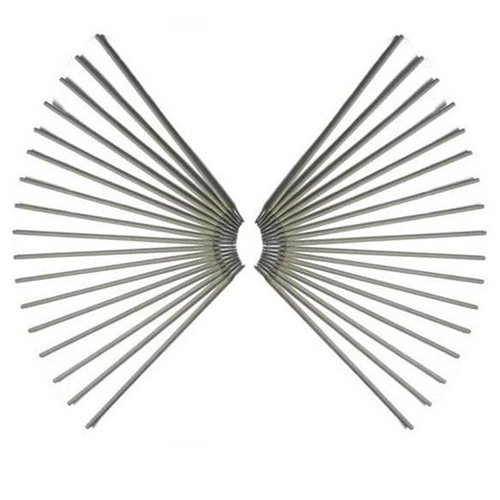CHARACTERISTICS & APPLICATIONS
ímet-9018NM2(H4R) are low-hydrogen iron powder potassium electrodes, intended to meet strength requirements after extended post weld heat treatment as required in the construction of nuclear power plants and in the fabrication of components (e.g., steam generators and pressurizers) used in nuclear power plants. In production environments, the length of post weld heat treatments can be as long as 48 hours. Increased carbon aids in achieving desired response to heat treatment. In addition to the requirements listed in this specification, these applications also often require drop weight testing to determine nil ductility temperature as well as measurement of mils of lateral expansion (0.38 mm minimum) on broken Charpy V-notch specimens.
These low-hydrogen electrodes produce weld metal that contains about 1.25% manganese, 1.75% Nickel and 0.33% molybdenum. This weld metal provides higher strength and better notch toughness than the C–0.5% Mo and 1% Ni–0.5% Mo steel weld metal. However, the weld metal from these Mn-Mo steel electrodes is quite air-hardenable and usually requires preheat and PWHT. The individual electrodes classified under this electrode group have been designed to match the mechanical properties and corrosion resistance of the high-strength, low-alloy pressure vessel steels, such as ASTM A514, A517, A543 Type B or C; NAVSEA Technical Publication T9074-BD-GIB–010/0300 HY80 or HY100, UNS Nr K11630, K42339, K31820, K32045.
Storage and Drying Conditions: Not recommended | Ambient temperature (For R-Class)
Hydrogen can have adverse effects on welds in some steels under certain conditions. One source of this hydrogen is moisture in the electrode coverings. For this reason, the proper storage, treatment, and handling of electrodes are necessary.
Holding Ovens: 125°C–150°C Drying Conditions: 250°C–425°
CHEMICAL COMPOSITION OF UNDILUTED WELD
|
C |
Mn | Si | P | S | Ni | Cr | Mo |
Additional Elements |
|
0.04–0.15 |
0.50–1.60 | 0.70 | 0.02 | 0.02 | 1.40-2.10 | 0.20 | 0.20-0.50 |
V=0.05, Cu=0.10, Al=0.05 |
Single values are maxima, except where specified otherwise.
ALL-WELD-METAL MECHANICAL PROPERTIES (PWHT)
Preheat and Interpass : 95 to 110°C | Post weld Heat Treatment : 605±15°C for 8 Hour(s) The temperature shall be raised at the rate of 85°C to 280°C per hour and allowed to cool at a rate not greater than 200°C per hour, and may be removed from the furnace when the temperature of the furnace has reached 300°C and allowed to cool in still air.
|
Tensile Strength, MPa |
Yield Strength, At 0.2% Offset, MPa | Elongation % |
Charpy V-Notch Impact at -30°C, Joules |
|
620 |
530 | 17 |
27 |
Single values are minimal.
Impact test specimens are tested without thermal treatment.
Limit of Moisture Content, % by weight max: 0.20 max (Reconditioned) | 0.15 (As Exposed) for H4 version Diffusible Hydrogen Content Average, Maximum, mL(H2)/100 g Deposited Metal: 4.00
Welding Considerations
Preheat and interpass minimum temperatures also have a significant effect on the strength levels attained with certain low-alloy steel weld metals.
These weld metals are affected by rapid cooling rates which tend to produce more martensitic or bainitic microstructures. These microstructures will often exhibit higher yield and tensile strengths with a decrease in ductility.
The cooling rate can be retarded by utilizing a higher preheat and interpass temperature. The preheat and interpass temperature ranges given herein are adequate for the preparation of the test assemblies.
However, in actual production, users are encouraged to test their own procedures to verify that they have selected preheat and interpass temperatures which will produce desirable results in production.
Due to the thick covering and deep cup produced at the arcing end of the electrode, iron powder electrodes can be used very effectively with a “drag” technique. This technique consists of keeping the electrode covering in contact with the work piece at all times, which makes for easy handling. However, a technique using a short arc length is preferable if the 2.5 mm or 3.2 mm electrodes are to be used in other than flat or horizontal fillet welding positions or for making groove welds.
SIZES & CURRENT CONDITIONS (AC or DCEP)
|
DIAMETER, mm |
LENGTH, mm |
Amperes |
|
2.50 |
350 | 70-100 |
| 3.15, 3.20 | 350 |
115-155 |
|
4.00 |
350, 450 | 135-185 |
| 5.00 | 450 |
200-275 |
NOTE: H4 R variant is available for supply on request.
WARNING: Safety and health information is available from many sources, including, but not limited to Safety and Health Fact Sheets listed in A11.3, ANSI Z49.1 Safety in Welding, Cutting, and Allied Processes published by the American Welding Society, 8669 Doral Blvd., Suite 130, Doral, FL 33166., and applicable federal and state regulations. The Safety and Health Fact Sheets are revised, and additional sheets added periodically.

